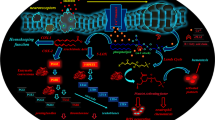Abstract
Leflunomide exerts its effects primarily via the immunomodulating and antiphlogistic activities of its major metabolite A 77 1726. Our investigation in several eicosanoid forming systems revealed that in human white blood cells the metabolite did not cause any alteration on Ca-ionophore stimulated metabolism of membrane bound arachidonic acid to cis-, trans- and epi-LTB4. Thus, the involved enzyme systems phospholipase A2, 5-lipoxygenase and LTA4-hydrolase can be ruled out as a target of the drug. However, in several cellular systems the drug weakly inhibited the generation of 5-HETE and LTB4 from exogenous arachidonic acid, possibly by interfering with the exogenous substrate's access to the 5-lipoxygenase.
In order to get information about the cyclooxygenase (COX-2) which is inducible in human PMNL by inflammatory mediators viade novo protein biosynthesis, we activated the cells with LPS for 18 h. A 77 1726 and indomethacin had no influence on the enzyme activity of the newly induced COX-2. However, both drugs in low concentrations were able to blunt the long term activation process resulting in PGE2 generation.
In contrast, the prostaglandins generated by constitutive enzymes (COX-1) are probably involved in maintaining vital functions, and their inhibition by indomethacin and other nonsteroidal antiinflammatory drugs (NSAIDs) account for numerous adverse effects, for instance gastric erosion.
Our study revealed that leflunomide and A 77 1726 are not to be regarded as COX-1-inhibitors, and thus cannot be associated with the typical adverse effects of the NSAIDs.
Similar content being viewed by others
References
J. Vane and R. Botting,Inflammation and the mechanism of action of anti-inflammatory drugs. FASEB J.1, 89–96 (1987).
B. Samuelsson,Leukotrienes and other lipoxygenase products. Prog. Lipid Res.25, 13–18 (1986).
W. L. Smith,The eicosanoids and their biochemical mechanisms of action. Biochem. J.259, 315–324 (1989).
W. Xie, D. L. Robertson, and D. L. Simmons,Mitogen-inducible prostaglandin G/H synthase: A new target for nonsteroidal antiinflammatory drugs. Drug Dev. Res.25, 249–265 (1992).
S. H. Lee, E. Soyoola, P. Chanmugam, S. Hart, W. Sun, H. Zhong, S. Liou, D. Simmons and D. Hwang,Selective expression of mitogen-inducible cyclooxygenase in macrophages stimulated with lipopolysaccharide. J. Biol. Chem.267, 25934–25938 (1992).
J. P. Merlie, D. Fagan, J. Mudd and P. Needleman,Isolation and characterization of complementary DNA for sheep seminal vesicle prostaglandin endoperoxide synthase. J. Biol. Chem.263, 3550–3553 (1988).
C. D. Funk, L. B. Funk, M. E. Kennedy, A. S. Pong and G. A. Fitzgerald,Human platelet/erythroleukemia cell prostaglandin G/H synthase: cDNA cloning, expression, and gene chromosomal assignment. FASEB J.5, 2304–2312 (1991).
B. J. R. Whittle,Temporal relationship between cyclooxygenase inhibition, as measured by prostacyclin biosynthesis, and the gastrointestinal damage induced by indomethacin in the rat. Gastroenterology80, 94–98 (1981).
R. T. Schoen and R. J. Vender,Mechanisms of nonsteroidal antiinflammatory drug-induced gastric damage. Am. J. Med.86, 449–458 (1989).
M. K. O'Brien, V. D. Winn and D. A. Young,cDNA cloning and functional activity of a glucocorticoid-regulated inflammatory cyclooxygenase. Proc. Natl. Acad. Sci. USA89, 4888–4892 (1992).
F. Herrmann, A. Lindemann, J. Gaus and R. Mertelsmann,Cytokine-stimulation of prostaglandin synthesis from endogenous and exogenous arachidonic acids in polymorphonuclear leukocytes involving activation and new synthesis of cyclooxygenase. Eur. J. Immunol.20, 2513–2516 (1990).
R. R. Bartlett, M. Dimitrijevic, T. Mattar, T. Zielinski, T. Germann, E. Rüde, G. H. Thoenes, C. C. A. Küchle, H.-U. Schorlemmer, E. Bremer, A. Finnegan and R. Schleyerbach,Leflunomide (HWA 486), a novel immunomodulating compound for the treatment of autoimmune diseases and reactions leading to transplantation rejection. Agents and Actions32, 10–21 (1991).
T. Zielinski, H.-J. Müller and R. R. Bartlett,Effects of leflunomide (HWA 486) on expression of lymphocyte activation markers. Agents and Actions38, C80-C83 (1993).
R. R. Bartlett, H. Anagnostopulos, T. Zielinski, T. Mattar and R. Schleyerbach,Effects of leflunomide on immune responses and models of inflammation. Semin. Immunopathol.14, 381–394 (1993).
H. Salari, P. Braquet and P. Borgeat,Comparative effects of indomethacin, acetylenic acids, 15-HETE, nordihydroguajaretic acid and BW 755c on the metabolism of arachidonic acid in human leukocytes and platelets. Prostagl. Leukotr. Med.13, 53–60 (1984).
J. Veenstra, H. van de Pol, H. van der Torre, G. Schaafsma and T. Ockhuizen,Rapid and simple methods for the investigation of lipoxygenase pathways in human granulocytes. J. Chromatogr.431, 413–417 (1988).
A. Boyum,Isolation of mononuclear cells and granulocytes from human blood. Scand. J. Clin. Lab. Invest.97, 77–89 (1968).
P. Borgeat and B. Samuelsson,Arachidonic acid metabolism in polymorphonuclear leukocytes: Effect of ionophore A 23187. Proc. Natl. Acad. Sci.76, 2148–2152 (1979).
G. Vandeplassche, M. Clayes, W. Oyaert and A. Houvenagh,Influence of prostaglandins of bovine abomasum: Biosynthesis and in vitro motility experiments. Prostagl. Leukotr. Med.14, 15–34 (1984).
W. S. Powell,Reversed-phase high-pressure liquid chromatography of arachidonic acid metabolites formed by cyclooxygenase and lipoxygenase. Anal. Biochem.148, 59–69 (1985).
D. A. Ahlquist, J. A. Duenes, T. H. Madson, J. C. Romero, R. R. Dozois and J.-R. Malagelada,Prostaglandin generation from gastroduodenal mucosa: Regional and species differences. Prostaglandins24, 115–125 (1982).
M. Hemler, W. E. M. Lands and W. L. Smith,Purification of the cyclooxygenase that forms prostaglandins. J. Biol. Chem.251, 5575–5581 (1976).
D. Ruppert and K. U. Weithmann,HL 725, an extremely potent inhibitor of platelet phosphodiesterase and induced platelet aggregation in vitro. Life Sci.31, 2037–2043 (1982).
K. Daeves and A. Beckel,Grosszahl-Methodik und Häufigkeits-Analyse, 2. Auflage, Verlag Chemie, Weinheim, 1958.
A. Hatzelmann, R. Fruchtmann, K. H. Mohrs, S. Raddatz and R. Müller-Peddinghaus,Mode of action of the new selective leuktriene synthesis inhibitor Bay X 1005 and structurally related compounds. Biochem. Pharmacol.45, 101–111 (1993).
E. A. Meade, W. L. Smith and D. L. DeWitt,Differential inhibition of prostaglandin endoperoxide synthase (cyclooxygenase) isozymes by aspirin and other non-steroidal antiinflammatory drugs. J. Biol. Chem.268, 6610–6614 (1993).
Author information
Authors and Affiliations
Rights and permissions
About this article
Cite this article
Weithmann, K.U., Jeske, S. & Schlotte, V. Effect of leflunomide on constitutive and inducible pathways of cellular eicosanoid generation. Agents and Actions 41, 164–170 (1994). https://doi.org/10.1007/BF02001911
Received:
Accepted:
Issue Date:
DOI: https://doi.org/10.1007/BF02001911




